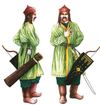Eurasian Steppes Flashcards

Eurasian Steppe Belt- grasslands from China to Europe.

Dmanisi, Georgia - 1.8 million year old. 5 Homo Erectus Skulls found. Oldest Hominins in Europe.

Denisovan cave - Siberia, 40,000 ya. Modern human teeth found belonging to ‘Denisovsan men’. Showed there may have been other, yet unknown species of Homo.

Mezhirych, Cherkasy Oblast, Ukraine. 14-15kya. Constructed houses from mammoth skulls, bones and tusks - no wood due to the flat steppe landscape. Fireplaces burnt bones and mammoth fat. Gravettian culture.

Gold bulls found at Maikop in the Caucasus, Russia. Also pottery and a burial mound with mesopotamian objects, showing trade. 3700-3100 BCE.

Many Steppe cultures buried with their horses after the start of domestication in 3200 BC and the use of chariots in 2000 BC.

Cimmerians- 1000BC. First to use Iron in the Steppes. First to use mounted warriors/ archers.

Greek Colonies in the Black Sea. 700 - 600 BC - colonised the wider Eurasian Steppe Belt.

Arzhan, Siberia, Russia- Tombs with 20kg of fold inside. Scythians with origins in Asia. 9th to 8th centuries BCE.

Pazyryk, Russia. Permafrost preserved bodies and organic material, including tattoos. Scythian. Also had the oldest preserved carpet in the world, 300-200 BC. 600-300 BC.

Huns - 5th century AD from the Ural river to the Atlantic. Warriors/ Invaders with metal cauldrons and gold jewellery. Pots cast in bronze in the Chinese way and brought the Europe. Atillas empire was the centre of Europe.

Obernai addpated skull, found in Alsace, France, from a Chinese tradition transmitted across the Eurasian Steppes. Found with earrings and a golden comb, and beads. Germanic women started using the tradition on their children. 365 AD

Alvar - Hungarians, buried with horses, belts and stirrups. 7th -9th century.

Petchenegs - buried curled up with long bows, Romania. 8th c.

Magyar - hungarians, buried with horses. 4th/5th c AD.

Mongol Invasions - warriors from Mongolia, buried with their horses. 8th c.

Silk Road- trade of silk from China to Europe via the Steppes. Began in 200BC. Traded silk, traditions and ideas.

Botai, c. 3700–3100 BC in ancient Kazakhstan
- pithouses
- Some researchers state that horses were domesticated by the Botai

Yamnaya- also called Pit Grave Culture and Ochre Grave Culture, was an early Bronze Age culture of the Ural region, dating to 3,600–2,300 BCE.

Sintashta -Bronze Age culture of the northern Eurasian steppe dated to the period 2100–1800 BCE. The earliest known chariots have been found in Sintashta burials, and the culture is considered a strong candidate for the origin of the technology. Associated with Bronze work and warfare.


